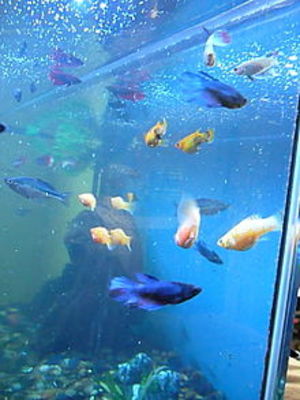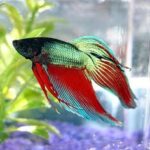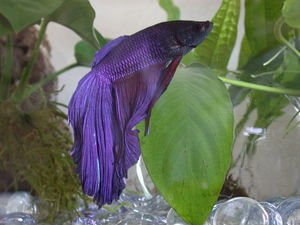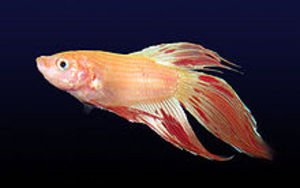Bettas (also called Siamese fighting fish) are arguably one of the easiest pet fish to care for. That doesn’t mean you should ignore their care or keep them in the tiny plastic bubbles that pet stores sell them in. But, compared to most other fish species, bettas will not need fancy food, a frantic eye on saline content and sometimes (depending on where you live) don’t even need a heating system. Their beauty, grace and feistiness makes you feel as if you are caring for a living work of art rather than just a tiny fish.
They Didn’t Always Look Like That
The bettas seen in pet stores and many hobbyists’ tanks (Betta splendens) did not always look like they do now. We don’t know how many centuries of careful selective breeding went on in order to produce the haughty little fish we know and serve today. The original breeders in parts of Malaysia, Cambodia, Loas, Thailand (Siam), must have had a shining vision of a shining fish and did whatever they could to attain that vision.
The ancestors of today’s bettas were drab dark green or brown wild fish that could live in slow moving bodies of water, rice paddies and puddles, even jumping from puddle to puddle when the mood struck them (such as when there was a hot female ready to spawn in the next puddle). This ancestor still survives. It is called “Plakat Thung” or “Plakat Pah” by the locals.
Perhaps this fish was chosen partially for its temper and partially because when angry, the males color changed and he would puff out his fins. Tiny little bright dots of color would appear in the Plakat Thung. They were used for pet fish and for fish fighting.
It’s Not Over Yet
The first Western fish lover who met a betta was Theodor Cantor in 1849, who promptly went on to misclassify the fish. The name Betta splendens didn’t emerge until matters were set straight in 1910 through the work of Charles Tate Regan, FRS. The world was only used to certain betta colors. When the white or cream variety appeared, it was first thought to be of a different species.
And the Betta is not finished going through whatever artistic palette in its genes. New varieties are seemingly cropping up every week, with variations in color, pattern, fin length and fin shape. However, their temper remains high and their needs remain low.
Basic Care
Each betta needs at least a one gallon tank or Bio-orb to live in. Although female bettas can get along with many other kinds of community freshwater fish like tetras and danios, the males must be kept in their own tanks. They will kill or harass any other fish especially other bettas. Females can also be aggressive, even to other female bettas. Female bettas usually are not as aggressive towards other community tropical fish species as males. Very fast swimming fish will often find the slow-swimming male betta an easy target to harass and don’t let him get a fair share of the food. Keep a small tunnel or other decoration in the tank so the betta or another smaller fish can hide there if things get tense in the community tank.
Bettas love frozen or freeze-dried bloodworms and also like brine shrimp. Some will adapt to eating flakes or pellets, but most will just ignore it. Bettas will occasionally feed on algae, especially in the form of algae wafers left for bottom feeders, but prefer the carnivorous life.
References
“Freshwater Aquariums for Dummies, Second Edition.” Maddy Hargrove & Mic Hargrove. Wiley Publishing; 2006.
“Aquarium Care of Bettas.” David E. Boruchowitz. TFH Publishing: 2006.
Author’s personal experience





